Southeast Asia Waste-to-Energy Market Size
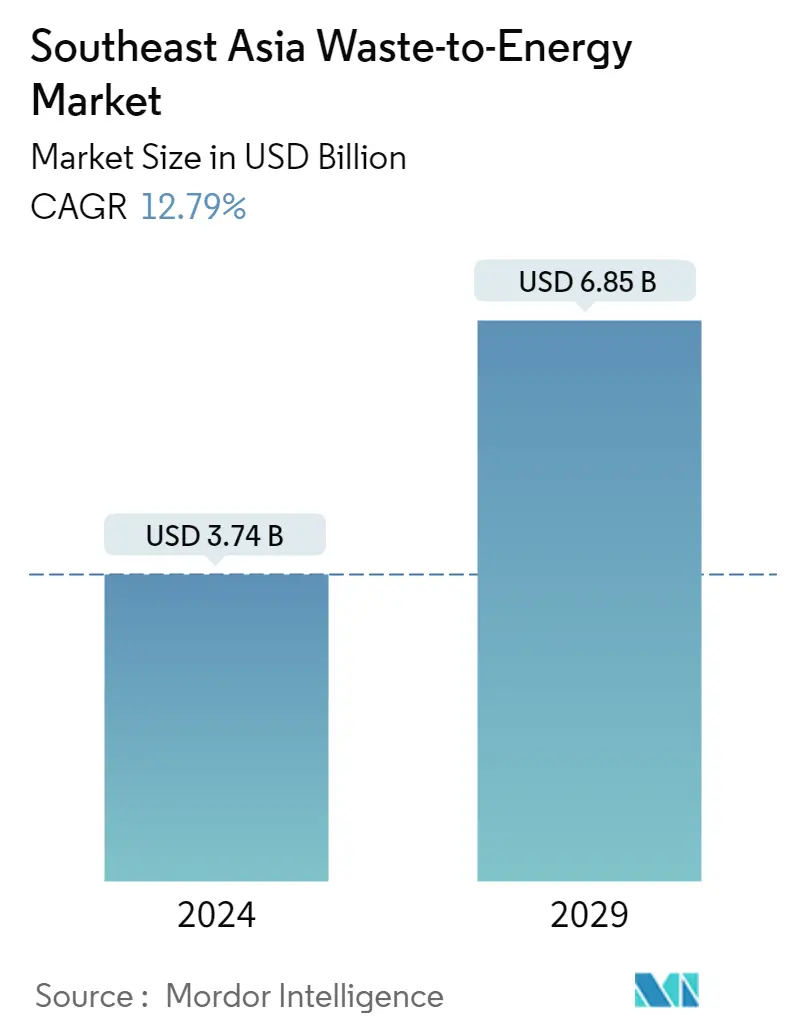
| Study Period | 2019 - 2029 |
| Base Year For Estimation | 2023 |
| Market Size (2024) | USD 3.74 Billion |
| Market Size (2029) | USD 6.85 Billion |
| CAGR (2024 - 2029) | 12.79 % |
| Market Concentration | Medium |
Major Players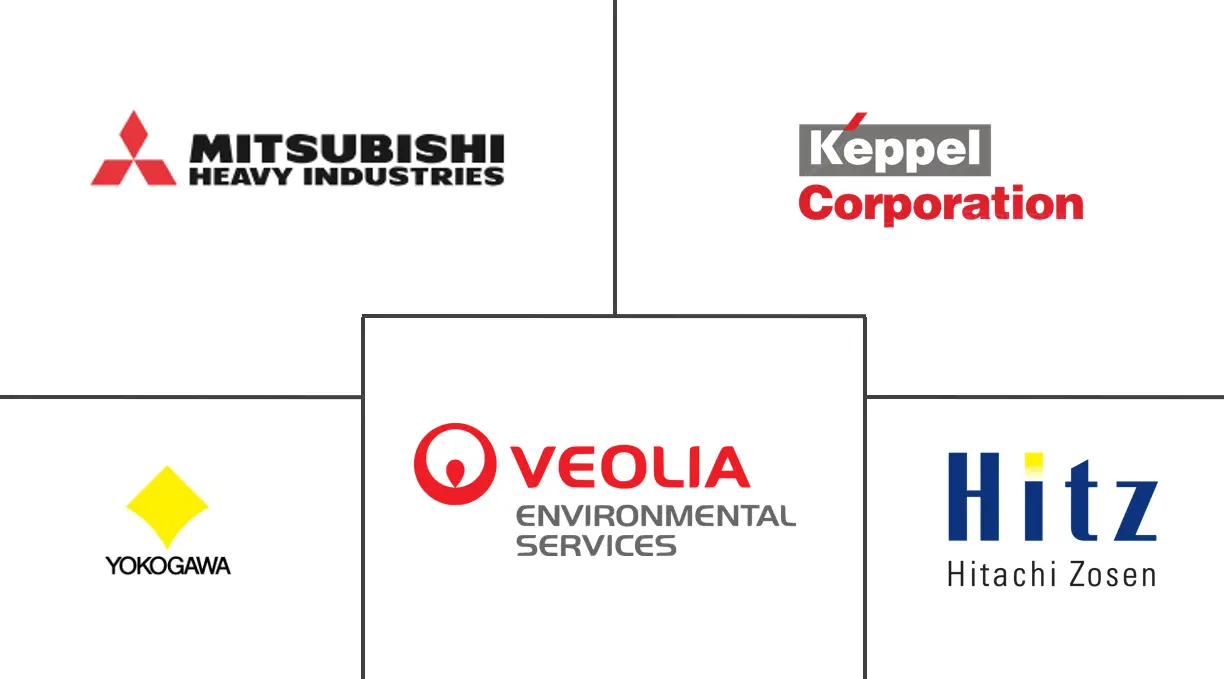
*Disclaimer: Major Players sorted in no particular order |
Southeast Asia Waste-to-Energy Market Analysis
The Southeast Asia Waste-to-Energy Market size is estimated at USD 3.74 billion in 2024, and is expected to reach USD 6.85 billion by 2029, growing at a CAGR of 12.79% during the forecast period (2024-2029).
- Over the long term, the increasing amount of waste generation, growing concern for waste management to meet the need for sustainable urban living, and increasing focus on non-fossil fuel sources of energy are driving the demand for the Southeast Asia Waste-to-Energy Market.
- Conversely, the high capital costs are expected to hinder market growth during the study period.
- Nevertheless, emerging waste-to-energy technologies, such as Dendro Liquid Energy (DLE), are expected to create significant opportunities for market players over the coming years. It is four times more efficient in terms of electricity generation, with the additional benefits of no emission discharge and effluence problems at plant sites,
- Malaysia is one of the fastest-growing countries in the Southeast Asian region. The country ramped up its efforts in improving waste management, in which waste-to-energy plays a key role.
Southeast Asia Waste-to-Energy Market Trends
Growing Demand for Thermal-Based Waste-to-Energy Conversion
- Thermal-based waste-to-energy conversion refers to utilizing thermal energy to convert waste materials into usable forms of energy, such as electricity, heat, or fuel. This approach involves the application of various technologies that use heat as a catalyst for converting waste into energy.
- Rapid population growth and urbanization led to a significant increase in waste generation, posing challenges for waste management. Thermal-based waste-to-energy conversion effectively manages and reduces the waste volume that must be landfilled or incinerated.
- In January 2023, Harvest Waste, a company based in the Netherlands (formerly Amsterdam Waste Environmental Consultancy and Technology), commenced initial studies for a thermal waste-to-energy venture in the Mekong Delta province of Soc Trang in Vietnam. The project is estimated to cost around USD 100 million.
- There is a growing need for reliable and sustainable energy sources. Thermal-based waste-to-energy technologies allow waste conversion into usable energy forms, such as electricity and heat. It contributes to energy generation and helps diversify the energy mix, reducing dependence on fossil fuels.
- Southeast Asia includes one of the fastest-growing urban populations globally. The rapid growth in the urban population led to explosive growth in the amount of waste generated by the urban population across the region. Most of this waste is organic (about or more than 50%) except in Singapore.
- With the growing population, the region's electricity demand increased significantly in recent years. For instance, in Thailand, electricity consumption increased by more than 3% between 2021 and 2022.
- Therefore, as per the above points, the demand for thermal-based waste-to-energy systems is expected to increase during the forecasted period.
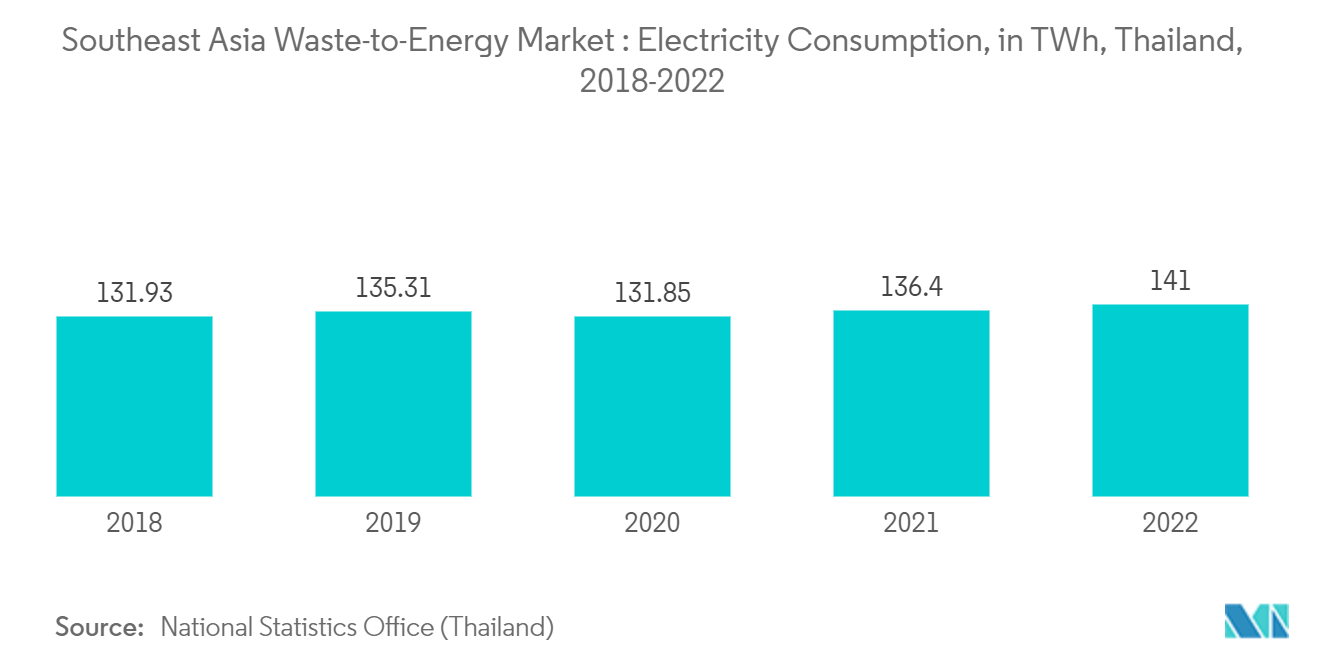
Malaysia Expected to Witness Significant Growth
- The Malaysian government actively promoted sustainable waste management practices and renewable energy development. They implemented various initiatives and policies to support the waste-to-energy sector, including feed-in tariffs, tax incentives, and regulatory frameworks. These measures create a conducive environment for investment and growth in the industry.
- Like many other countries, Malaysia is experiencing a rise in waste generation due to population growth, urbanization, and industrialization. It creates a pressing need for efficient waste management solutions. Waste-to-energy projects offer a sustainable method to tackle the growing waste volume while generating renewable energy.
- In May 2023, the Melaka state government ordered the expedited construction of the Waste to Energy (WTE) plant or incinerator at the Sungai Udang Sanitary Solid Waste Disposal Site. They aim to include the facility operational next year, earlier than the original target of 2026.
- Furthermore, Malaysia includes a significant proportion of organic waste, which is well-suited for waste-to-energy conversion processes. Organic waste, such as food waste and agricultural residues, can be efficiently utilized for anaerobic digestion or composting, leading to biogas or fertilizer production. The abundance of organic waste resources presents favorable conditions for waste-to-energy projects.
- Additionally, the Malaysian government set renewable energy targets to increase the share of renewable energy in the country's energy mix. Waste-to-energy technologies contribute to fulfilling these targets by generating renewable energy from waste resources. It aligns with the country's sustainability goals and supports the transition to a low-carbon economy.
- According to International Renewable Energy Agency, the total renewable energy installed capacity in 2022 was 9044 MW registering a growth rate of more than 20% between 2018 and 2022.
- Therefore, according to the above points, Malaysia is expected to play a key role in the market studies during the forecasted period.
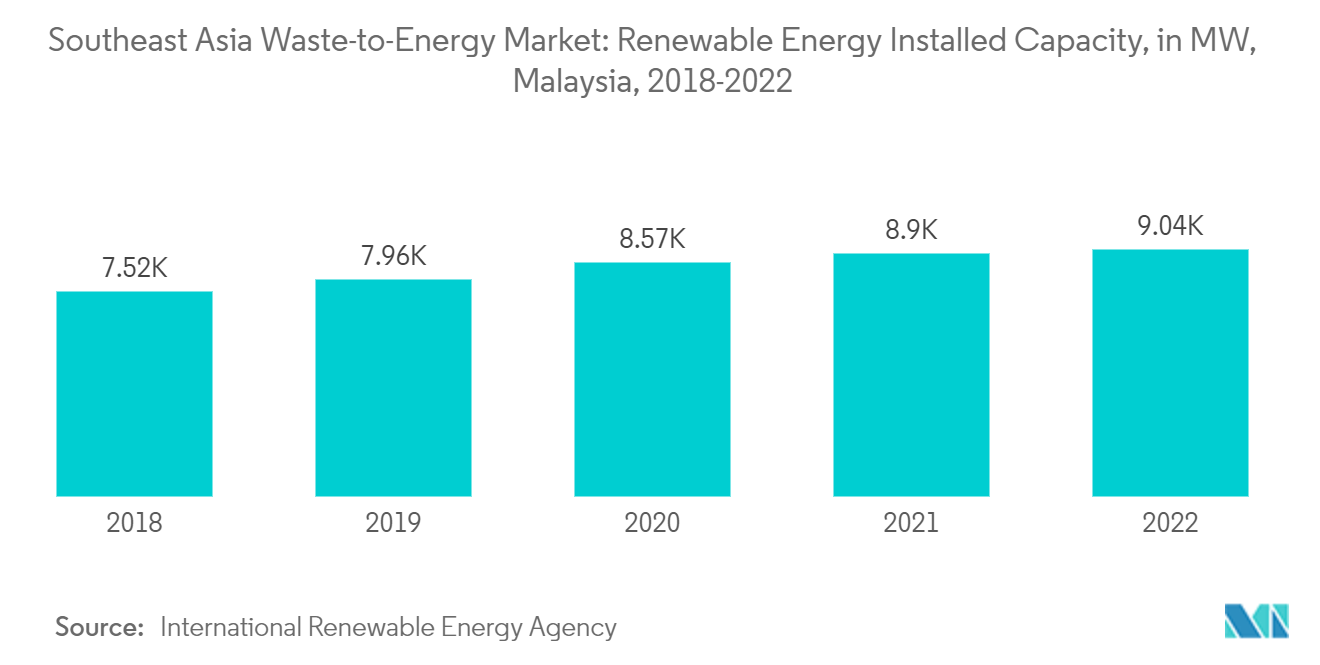
Southeast Asia Waste-to-Energy Industry Overview
The Southeast Asia waste-to-energy market is moderately consolidated. The key players in the market (in no particular order) include Mitsubishi Heavy Industries Ltd, Keppel Corporation, PT Yokogawa Indonesia, Veolia Environment SA, and Hitachi Zosen Corp, among others.
Southeast Asia Waste-to-Energy Market Leaders
-
Mitsubishi Heavy Industries Ltd
-
Keppel Corporation
-
PT Yokogawa Indonesia
-
Veolia Environment SA
-
Hitachi Zosen Corp
*Disclaimer: Major Players sorted in no particular order
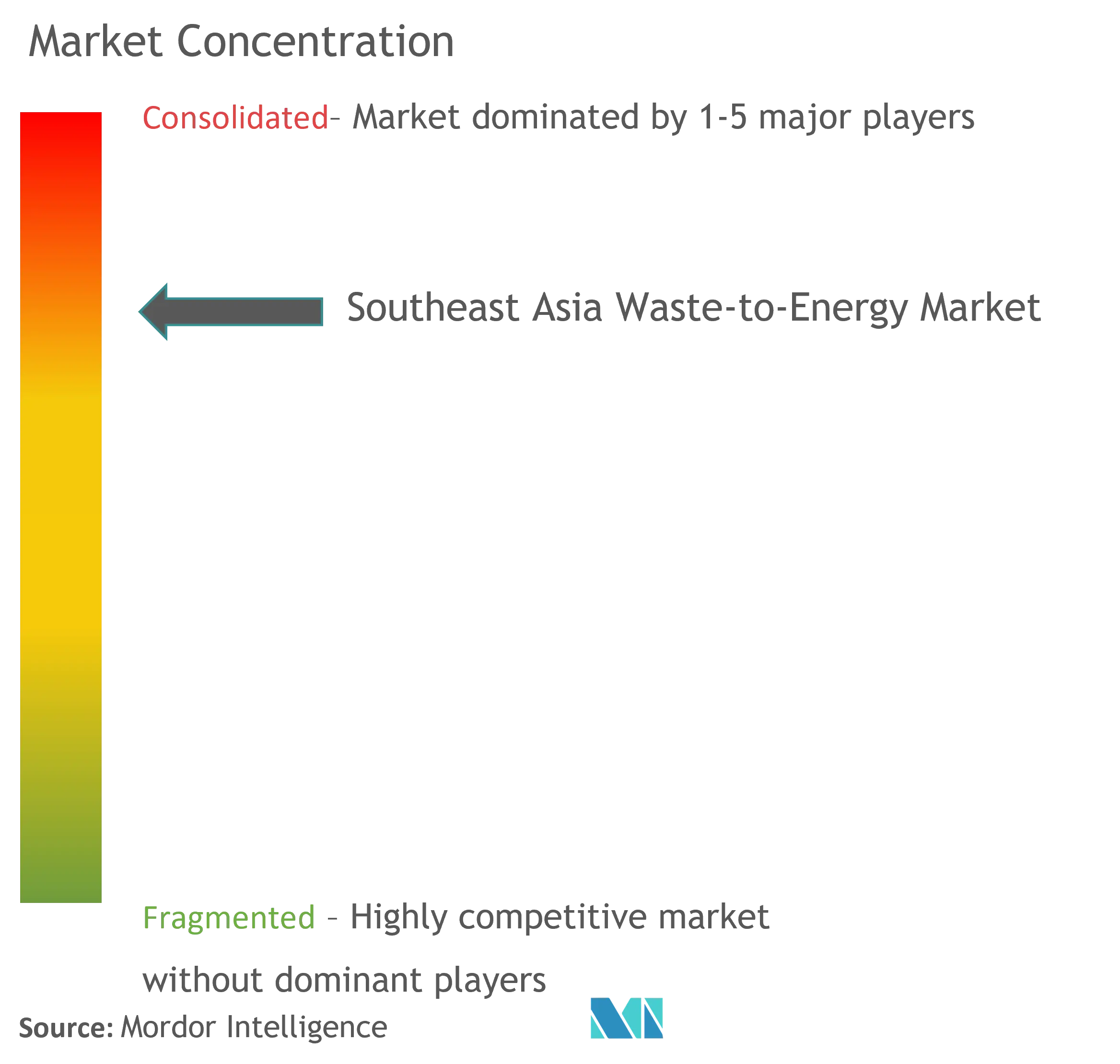
Southeast Asia Waste-to-Energy Market News
- October 2023: The Thailand Board of Investment (BOI) approved an investment for promoting applications worth a combined USD 1.1 billion in projects, including the manufacturing of electric vehicles (EV), the generation of renewable energy from waste, data centers, and travel and tourism infrastructure and equipment. Further, C&G Environmental Protection (Thailand) Co., Ltd. received approval for a USD 0.13 billion investment in a 35-megawatt power generation project that will produce electricity from waste. The facility will be located in the area of the Nong Khaem Solid Waste Disposal Center in Bangkok.
- September 2022: PT Jakarta Propertindo (Jakpro), a city-owned developer, announced that the construction of Jakarta's inaugural waste-to-energy incinerator in Sunter, North Jakarta, will begin by the end of 2022.
Southeast Asia Waste-to-Energy Market Report - Table of Contents
1. INTRODUCTION
- 1.1 Scope of the Study
- 1.2 Market Definition
- 1.3 Study Assumptions
2. EXECUTIVE SUMMARY
3. RESEARCH METHODOLOGY
4. MARKET OVERVIEW
- 4.1 Introduction
- 4.2 Market Size and Demand Forecast in MW, till 2028
- 4.3 Recent Trends and Developments
- 4.4 Government Policies and Regulations
-
4.5 Market Dynamics
- 4.5.1 Drivers
- 4.5.1.1 Increasing Waste Generation
- 4.5.1.2 Environmental Concerns and Sustainability Goals
- 4.5.2 Restraints
- 4.5.2.1 High Capital Costs Involved in Waste-to-Energy Infrastructure
- 4.6 Supply Chain Analysis
-
4.7 Industry Attractiveness - Porter's Five Forces Analysis
- 4.7.1 Bargaining Power of Suppliers
- 4.7.2 Bargaining Power of Consumers
- 4.7.3 Threat of New Entrants
- 4.7.4 Threat of Substitutes Products and Services
- 4.7.5 Intensity of Competitive Rivalry
5. MARKET SEGMENTATION
-
5.1 Technology
- 5.1.1 Physical
- 5.1.2 Thermal
- 5.1.2.1 Incineration
- 5.1.2.2 Co-processing
- 5.1.2.3 Pyrolysis/gasification
- 5.1.3 Biological
- 5.1.3.1 Anaerobic Digestion
-
5.2 Geography Regional Market Analysis {Market Size and Demand Forecast till 2028 (for regions only)}
- 5.2.1 Malaysia
- 5.2.2 Indonesia
- 5.2.3 Thailand
- 5.2.4 Singapore
- 5.2.5 Vietnam
- 5.2.6 Rest of Southeast Asia
6. COMPETITIVE LANDSCAPE
- 6.1 Mergers and Acquisitions, Joint Ventures, Collaborations, and Agreements
- 6.2 Strategies Adopted by Leading Players
-
6.3 Company Profiles
- 6.3.1 Mitsubishi Heavy Industries Ltd
- 6.3.2 Keppel Corporation
- 6.3.3 PT Yokogawa Indonesia
- 6.3.4 Veolia Environment SA
- 6.3.5 Hitachi Zosen Corp
- 6.3.6 MVV Energie AG
- 6.3.7 Martin GmbH
- 6.3.8 Babcock & Wilcox Volund AS
- *List Not Exhaustive
7. MARKET OPPORTUNITIES AND FUTURE TRENDS
- 7.1 International Collaborations and Investments
Southeast Asia Waste-to-Energy Industry Segmentation
Waste-to-energy (WtE) refers to converting various waste materials into usable forms of energy, such as electricity, heat, or fuel. It involves the application of different technologies to extract energy from waste, thereby reducing the volume of waste that needs to be landfilled or incinerated. The most common waste materials used in waste-to-energy processes include municipal solid waste (MSW), biomass, agricultural residues, industrial waste, and wastewater sludge. These waste materials are typically rich in organic content, which can be harnessed for energy generation.
The Southeast Asia Waste-to-Energy Market is segmented by technology and geography. By technology, the market is segmented into physical, thermal, and biological. The report also covers the market size and forecasts for the Southeast Asia Waste-to-Energy market across the major countries in the region. Each segment's market sizing and forecasts are based on revenue (USD).
| Technology | Physical | |
| Thermal | Incineration | |
| Co-processing | ||
| Pyrolysis/gasification | ||
| Biological | Anaerobic Digestion | |
| Geography Regional Market Analysis {Market Size and Demand Forecast till 2028 (for regions only)} | Malaysia | |
| Indonesia | ||
| Thailand | ||
| Singapore | ||
| Vietnam | ||
| Rest of Southeast Asia |
Southeast Asia Waste-to-Energy Market Research FAQs
How big is the Southeast Asia Waste-to-Energy Market?
The Southeast Asia Waste-to-Energy Market size is expected to reach USD 3.74 billion in 2024 and grow at a CAGR of 12.79% to reach USD 6.85 billion by 2029.
What is the current Southeast Asia Waste-to-Energy Market size?
In 2024, the Southeast Asia Waste-to-Energy Market size is expected to reach USD 3.74 billion.
Who are the key players in Southeast Asia Waste-to-Energy Market?
Mitsubishi Heavy Industries Ltd, Keppel Corporation, PT Yokogawa Indonesia, Veolia Environment SA and Hitachi Zosen Corp are the major companies operating in the Southeast Asia Waste-to-Energy Market.
What years does this Southeast Asia Waste-to-Energy Market cover, and what was the market size in 2023?
In 2023, the Southeast Asia Waste-to-Energy Market size was estimated at USD 3.32 billion. The report covers the Southeast Asia Waste-to-Energy Market historical market size for years: 2019, 2020, 2021, 2022 and 2023. The report also forecasts the Southeast Asia Waste-to-Energy Market size for years: 2024, 2025, 2026, 2027, 2028 and 2029.
Southeast Asia Waste-to-Energy Industry Report
Statistics for the 2024 Southeast Asia Waste-to-Energy market share, size and revenue growth rate, created by Mordor Intelligence™ Industry Reports. Southeast Asia Waste-to-Energy analysis includes a market forecast outlook to 2029 and historical overview. Get a sample of this industry analysis as a free report PDF download.



